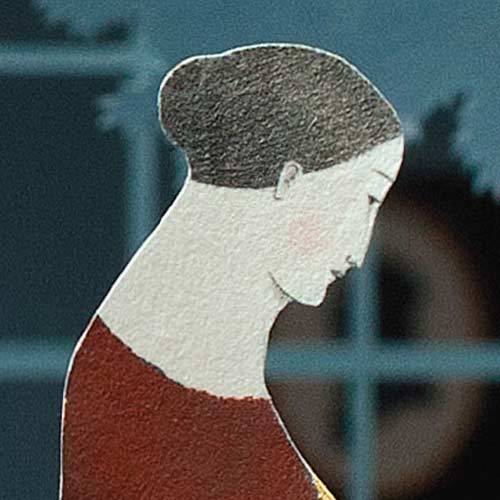< Back to posts
Elena Odriozola
Spain

Elena Odriozola worked at an advertising agency before becoming a children's book illustrator. She was a winner of the third CJ Picture Book Awards in Korea, her work was selected for the exhibition of the guest country at the Bologna Children's Book Fair, and she was nominated for the prestigious Astrid Lindgren Memorial Award.
In this post, Elena talks about her unique approach to illustrating Mary Shelley's ‘Frankenstein’, and she shares some development work, final illustrations, behind-the-scenes photos and a trailer for the book. This strikingly original interpretation of the much-loved classic was published by Nórdica Libros in 2013.
Elena: I have to confess that, although I find it a little embarrassing, I had never read Frankenstein until I was commissioned to illustrate the book. That's what sometimes happens when you've seen movie adaptations and so many other images that are a part of our collective memory. You get the feeling that you already know the story, and then it's harder to read it. Or at least that's what happens to me. In any case, I have not seen any Frankenstein as fearsome as the one that I imagined.
I also have to confess that while I read the book, at times I was scared. The scariest part was the monster's ‘watery eyes’, and his black lips and extremely white teeth. I pictured him as terrible – unimaginably terrible. So much so that it wasn't even worth it to draw him. The mental image of those eyes would be scarier than anything I could draw. I was also impressed by the speeches – whole paragraphs full of such rich vocabulary. And there was something else that surprised me. Dr. Frankenstein must have dug up a basketball team to create his creature; unless he was wearing huge shoes like in the movie, you tell me how else the monster could be as tall as he is described in the book. Whatever the case, I was always right there with him.
A lot of editors wouldn't have thought of me to illustrate this book, and I was really happy when Diego Moreno of Nórdica Libros offered it to me. To illustrate a book with such an ingrained iconography is always a challenge. And what I appreciated most was that they entrusted it to me without demanding a particular aesthetic. The usual practice is that editors think they already know what you're going to give them, and this is something that's always bothered me – and increasingly so as time goes on.
I think I've created something quite distinct from the story that's told. Although it's distinct from its characters and setting, I feel that it captures the essence of the book: the irresponsibility and the guilt it entails.
Once I was clear about what I wanted to convey, I got down to drawing.
I liked the results, but something was missing. I wanted to keep the setting and the characters, but for whatever reason I thought that wouldn't work. I'm not sure why, but I thought that it would be better if I turned it into a representation. So I started playing around. At first I tried to create a little movable theatre with the smallest possible number of pieces. But that idea didn't work, and the little theatre turned into a great hulking thing.
Just like what happened to Frankenstein, I had to glue the pieces of the little theatre together, because if I’d tried to join them on just one side, the other side would be out of balance. I tried to tell myself that the final result was the most important thing – the photography (which was done by my photographer friend, Perdinande Sancho) and not the intricacies – but in my heart of hearts, I still felt a little guilty.
To achieve the desired effect, I gave the theatre true depth by making a very long stage. I also decided that I had to maintain the size of the character, as this is something I do in all of my books. So in the photos, the smallest figure you see is that way because it's actually far away. This created focus problems.
I drew the character quite a bit bigger than the original version. I then scanned it into the computer and printed it on Sumi-e paper.
Once it was printed, I traced the lines and painted it with acrylic. I did it this way because if I'd drawn the face actual size, I wouldn't have been able to give enough definition to the expressions – and that's really important to me.
The depiction is carried out in two settings: the interior of the house with views to the outside, and the exterior of the house with a view to the inside. And the time portrayed goes from summer to winter. I substituted the usual white of my drawings for dark blue, which in my opinion was necessary for a horror story such as this. I think it's much more frightening to come face to face with a monster in the dark. Well, everything is more frightening in the dark.
Like I said, if Dr. Frankenstein's monster had been too detailed, it wouldn't have worked for me. Those watery eyes are much more terrifying to imagine. We create the monster in our own minds.
Illustrations © Elena Odriozola. Photographs © Perdinande Sancho. Post translated by Gengo and edited by dPICTUS.
Frankenstein
Mary Shelley & Elena Odriozola
Nórdica Libros, Spain, 2013
‘Frankenstein: Or, The Modern Prometheus’ was written by the English author, Mary Shelley, and first published in 1818. The novel is considered to be one of the earliest examples of science fiction.
This beautifully illustrated book by Elena Odriozola is a unique interpretation of the much-loved story.
















